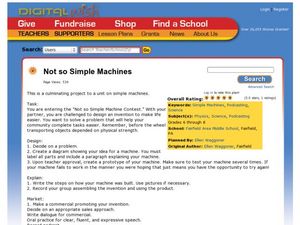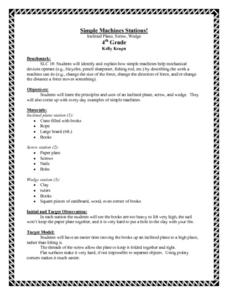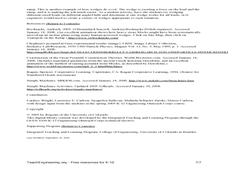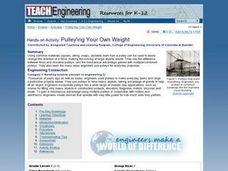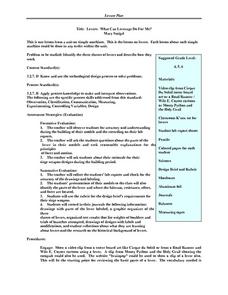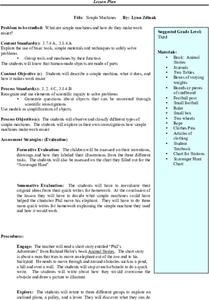Norwich Institute for Language Education
Simple Machines
Planning a unit on simple machines? Save some time and energy with this collection of lessons and activities that explores how these devices are used in the real world to make life a little easier.
Purdue University
Simple Machines
What's the best way to use a simple machine to solve a real-world problem? Scholars construct their own simple and complex machines to explore the concepts of work and force. They discuss examples of simple machines they have found in...
Curated OER
Teaching About Simple Machines
Students identify six different simple machines. They investigate the difference between the ideal and actual mechanical advantage. Students calculate the actual mechanical advantage for several simple machines.
Curated OER
Not So Simple Machines
Middle schoolers design a simple machine for a simple machine contest. For this simple machine lesson, students design a simple machine that will solve a problem. They draw a diagram, label it, and test the machine before they present it...
Curated OER
Simple Machines Stations!
Fourth graders investigate the principles and uses of an inclined plane, screw, and wedge and identify examples of simple machines. They rotate through three experiment stations, complete a worksheet for each station, and read a handout...
Curated OER
Summer Machines Activity: How Can We Move This Box of Blocks?
Students discover there's more than one way to move a heavy load. In this problem solving lesson, students use observation and problem-solving skills as they experiment with simple machines in order to transport loads.
Curated OER
Inclined Plane and Pulley
Students describe how inclined plane and pulleys make work easier. In this physics lesson plan, students calculate work done and mechanical advantage of both simple machines. They collect data from the experiment and construct graphs.
Curated OER
Simple Machines - Graphics, Experiments, Animation
Twelfth graders display simple machines through the use of graphics, experiments, and animation. They apply problem solving and design and skills.
Curated OER
Design Your Own Rube Goldberg Machine
Students participate in a culminating activity for a unit on Energy and Simple Machines. They are challenged to incorporate simple machines in to a complex mechanical system. While designing and testing their machine they will also...
Curated OER
Simple Machines
Third graders examine and identify the six types of simple machines. Using a model of each simple machine, they demonstrate the state the function of them to the class. They discover examples of simple machines at school and home and...
Curated OER
Simple machine Webqest
Third graders explore simple machines. Using specified Internet sites, 3rd graders gather information on types of machines. They define vocabulary words and locate examples of different types of simple machines. Students invent a new...
Curated OER
Pyramid Building: How to Use a Wedge
Learners explore the simple machine of a wedge. For this wedge lesson, students test wedges on different materials including wax, soap, clay and foam. They learn how a wedge was used to build the ancient pyramid and modern day skyscrapers.
Curated OER
My Crazy Contraption
Fourth graders design a contraption, which contains five different examples of simple machines and works without intervention. They sketch designs and label its parts. They present their creations to the class and relate them to Rube...
Curated OER
How Gear Systems Work: A Research Project
Students apply information regarding simple machines along with the math concept "ratios." The teacher introduces the concept that technology is the application of scientific knowledge and mathematics concepts to solve a problem. This is...
Curated OER
TE Activity: Pulley'ing Your Own Weight
Students experiment with common objects such as spools, string and soap to determine how pulleys make it easier to move large objects. They look at the difference between fixed and movable pulleys. They examine the many uses engineers...
Curated OER
Levers: What Can Leverage Do For Me?
Students determine the identity of the three classes of levers while explaining how each works. They wait a video clip that shows uses for different types of levers and work as a class to write a KWL chart. Finally, they make a model fo...
Curated OER
Simple Machines
Third graders listen to a short story entitled, "Phil's Adventures" from a book called Animal Stories. They stop at each obstacle in the story and do a quick write about how they would overcome the obstacle and draw a picture to...
Curated OER
Simple Machines/Technology
Third graders examine the concept of work as the movement of an object through a distance. They define gravity and determine what type of work is caused by gravity. They measure how far an object is moved by a force. They make a...
Curated OER
It's So Simple
Students use basic materials to create four simple machines. In this introduction to simple machines instructional activity, students are given four different scenarios that require a simple machine in order to solve. The students use...
Curated OER
Catapult Unit
High schoolers understand the need for carefully defining the problem before searching for a solution. They understand the need for carefully defining the problem before searching for a solution. Students compare a variety of catapults...
Curated OER
Using Fulcrums
Students engage in a lesson that concentrates on the use of a lever and fulcrum. They define how a lever is used to lift a load. The lesson has background information to justify it. Students demonstrate how to use the lever while lifting...
Curated OER
Wheels, Gears, and Compound Machines
Fifth graders read selected pages from their science text and explain forces affected by wheels and axles. They read and discover that gears transfer forces and that gear combinations relate to compound machines.
Curated OER
Levers: Catapults
Students construct a catapult that shoots a cotton ball at least two meters using Legos, rubber bands, and plastic spoons. They discuss how the catapult works, and identify any problems they had with their experiment.
Curated OER
What Can We Lose? What Do We Lose as we Gain Force With A Lever?
Third graders view a demonstration of a teeter totter as a basis for assessing pre-knowledge of a lever. They create a KwL chart. Students work in small groups to conduct a variety of experiments. The first requires students to tie books...



